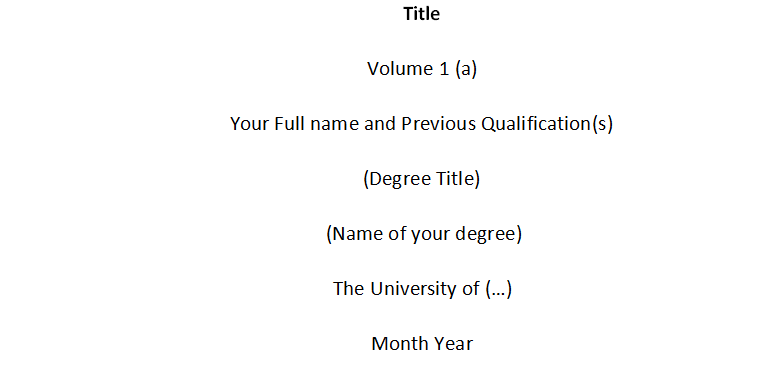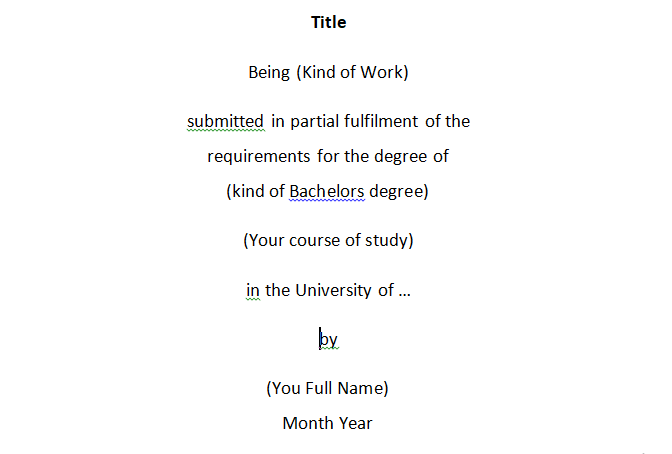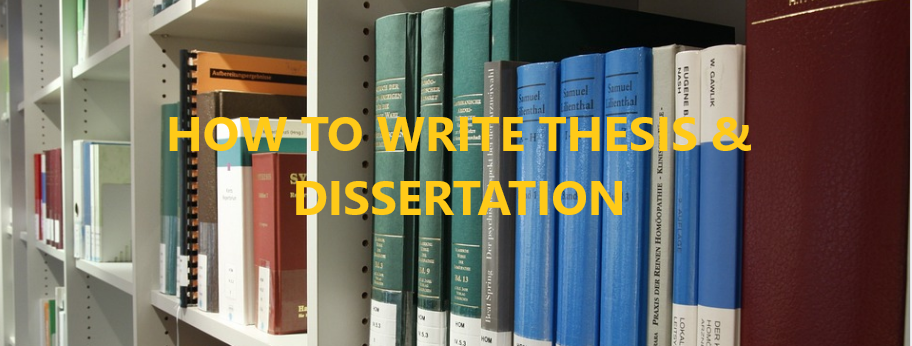How to Write Thesis and Dissertation | See the comprehensive guideline here.
Writing a good thesis and/or dissertation one of thesis of aspects postgraduate works that Postgraduate student do find difficult to tackle. This particular area needs to be specially thought by those who have in-depth knowledge in it.
That is the reason why I have decided to publish this article here for the benefit of all prospective postgraduate students, current postgraduate students and those who are interested in helping others who do not know how to write thesis and dissertation.
After reading this article, you will get all the necessary information and guidelines that you would require to make your work beautiful and standard.
These pages presents an overview of what needs to be considered when writing a postgraduate thesis or dissertation. For simplicity, in this article, I will be using “thesis” and “dissertation” interchangeably to describe both a PhD thesis and a Master’s dissertation.
See Also:
How To Write A Research Proposal | For International Scholarships And Grants
How To Write A Standard Personal Statement
How To Write A Motivational Statement
How to Write Thesis and Dissertation
The exact requirements for writing a thesis vary by discipline, so you should ask your supervisor if there are specific guidelines when starting to write your thesis. There are some central guidelines, however, which can be seen as follow:
The nature of a thesis
A thesis is an examinable document (possibly with annexes and additional material) that must:
- Display your knowledge of your chosen subject.
- Clearly demonstrate your ability to describe what you did and how and why you did it.
- Acknowledge which parts were done or helped by others.
- Be honest (no plagiarism!), factual, critical, and as interesting as it can be.
- Display your original contribution to knowledge (PhD thesis only).
Your thesis should argue and establish the grounds for believing a claim or conclusion; these grounds should be based on:
- Evidence from your own results
- Other evidence or accepted claims warranting you to draw the conclusion from your evidence.
Therefore you must:
- Make it clear what your central claim/conclusion is.
- Make it clear how your research supports the claim/conclusion.
- Keep the background (eg literature review) relevant to your argument linking data with conclusions
Tips about thesis structure
Your thesis should:
- Have a logical structure, not necessarily written in the chronological order in which you conducted your research.
- Make it clear why and how your results/design/analysis etc solves the problem you set out to solve.
- Provide a concise outline and summary of your research.
- Be clear about what you’ve discovered and why it’s important, original etc, both at the beginning and at the end.
Content of thesis
A typical thesis will contain the following:
- Title page:
Title, name affiliation & date.
- Table of contents:
This should show page numbering of chapters and appendices. It is also sometimes helpful to have lists of tables and figures.
- Abstract:
This is usually around 300 words.
- Acknowledgements:
Remember to acknowledge your funding body.
- Introduction:
It is often helpful to have one introductory chapter which outlines the thesis as a whole and indicates relevant sections where key elements of your argument may be found.
- Substantive chapters:
This is the main body of the thesis, typically a chapter for each study, but this will vary depending on the type of work you are presenting.
- Discussion:
You may want a separate major discussion chapter which puts the argument together and relates it back to the introduction. Your conclusion may be stated here or in a separate chapter. Don’t forget to include some discussion of the wider implications and future work
- Conclusions and suggestions for further work
- References/bibliography
- Appendices:
Your supervisor will give you guidance on what to include here, but this may contain materials used in studies, code listings etc.
Structure of substantive chapters
The structure of the substantive chapters will vary with discipline, but typical structures are as follows:
Qualitative/quantitative empirical theses:
- Introduction
- Methodology
- Results and analysis
- Discussion
- Conclusions
Theme-based theses:
- Chapter 1 : Theme/Text 1
- Chapter 2: Theme/Text 2
- etc
The literature review

The literature review is a fundamentally important component of your thesis. Your thesis has to show that you:
- Understand the body of knowledge.
- Understand the relevant research techniques – both those you chose to use and those you didn’t.
- Can conceive, implement and, where appropriate, modify a plan of research.
Therefore your literature review has to show:
- What the body of knowledge in your area is.
- What the relevant research techniques are – both those you chose to use and those you didn’t.
- Why you conceived, implemented and, where appropriate, modified the plan of research that you made – i.e. headed for something achievable that hadn’t been done before.
Tips on writing a literature review
- You need to start working on this at the beginning of your work to justify the originality of what you propose to do.
- You need to keep looking at the literature all the way through your project – otherwise there is a risk of your review becoming outdated.
- By the time you finish your thesis you will probably have chosen to omit 75% of the references you have looked at!
- What you leave out is almost more important as what you include – it shows you have judgement as to what is relevant to your argument.
What is a dissertation?

A dissertation is an extended piece of writing of between ten and twenty thousand words on a topic set by a department or one chosen by the student him or herself.
It is usually divided into chapters and may contain headings and sub-headings, and these are sometimes (though not always) numbered as in a report.
Dissertations answer a particular research question and can either report on an empirical study or on a literature-based study.
Although the purpose of a dissertation is to answer the question, the process is more important than the actual findings.
Even if you produce no usable data whatsoever, you can still get a first in your dissertation – as long as you can show that you have learned about the research process and are able to analyse it and understand why you were unable to answer the question as successfully as you may have wished.
Research
In order to prepare the literature review and to conduct further research into your chosen topic, you will need to search for relevant information. You may also need to conduct experiments or studies involving questionnaires and/or interviews. Time and care are needed for this process.
Your supervisor is the person who will advise on how to conduct studies – the form of the study, its scope, how to choose representative samples of respondents, any ethical issues, how to write questions to yield the kind of information required, the format of the questionnaire and so on.
Parts of a dissertation
These should always be agreed with your supervisor as they can vary. This is a typical structure but not an exclusive one.
The title
Getting this right is more crucial than you may think. If you decide on a title which is too vague, you run the risk of the dissertation lacking focus or cohesion and not making any specific points worthy of note.
| Construct a title which forces you to concentrate on something in particular, ask a specific question or make a specific comparison. |
You could have a two-part title where the first part, the main title, is short and perhaps rather general in nature but the second part very focused, picking up a particular aspect of the main title.
Alternatively, make the main title enigmatic, cryptic or apparently contradictory, followed by a sub-title which begins to explain what it is all about. This will make the reader curious to read more.
Abstract
This is a short summary, usually about 300 words in length, of the contents of the dissertation and perhaps its conclusions. Abstracts are filed in a database so that those searching for information of interest to them can see quickly whether or not your work will be of any use to them.
Despite the fact that it is placed at the beginning of the work, it is much easier – and will save you a great deal of trouble – if it is written last of all; that way, you can ensure that the contents of the abstract exactly match the contents of the dissertation.
Introduction
The should include (this list is not exclusive):
- Aims and objectives of the research.
- Context of the research.
- Explanation of any key terms used.
- Acknowledgement of any limitations or exclusions (This research will not cover…) if necessary.
- Description of the structure/shape of the dissertation.
Literature review
The literature review places your dissertation within the body of existing research and literature and justifies your choice of question. As you read further, you will see more detailed information on writing literature review for dissertation.
Methodology
This is an explanation of how you are going to answer the research question. You need to explain what methods you will be using to collect and analyse your data and justify any decisions you have made with reference to more literature as appropriate.
Findings and discussion
If you have undertaken an empirical study generating primary data then these will probably be written as two separate sections – perhaps with a ‘results’ section first.
If you have undertaken literature based research using secondary data then they tend to be written together (this is not a strict rule and you should always discuss it with your supervisor).
The findings explain your data and the results of your analysis to the reader. They should be clear and logical.
The discussion is the central part of your dissertation. It should include no new information or data but look at the meaning of your findings. You should also discuss any problems and your explanation of why they occured and how they could be solved or avoided in any future research.
Conclusion (and sometimes recommendations)
How well did your research answer the question? Summarise what you can now say about the title of your dissertation. Suggest where the research could go from here.
References/bibliography
These are not the same.
- A reference list is a list of all the works from which you have quoted or which you have specifically referred to in the dissertation.
- A bibliography is a list of all works you have read or part-read during the preparation of the dissertation, including those to which you have not made any reference at all, but which have helped you formulate your ideas or given you further information.
Sometimes, departments allow you to combine the two – check this with your supervisor.
Appendices
These include anything that the marker may wish to see but which is not included in the main text. This often includes blank questionnaires, covering letters, letters of consent, any original statistical analysis (tables).
You will rarely be asked to include all of your raw data such as completed questionnaires or full transcripts of interviews. Your supervisor will advise you.
Literature Review (for dissertations)

A literature review summarises what has already been written about your topic so that:
- You do not repeat work already done.
- The reader is able to distinguish between your work and ideas and those of others.
- There is a basis from which your own study can begin and, hopefully, which you can extend.
- You can demonstrate that you have read and understood the work already carried out and are therefore in a better position to continue study in that area.
- You can justify the relevance of your dissertation.
- You can justify the methodology you have chosen to use.
How well you are able to do the review may depend on your title:
| Too vague or all-encompassing = too much material to sift through. Too focused or specialised = too little information to review. |
Structure of a Literature Review (for Dissertation)
As a general rule, it is best to start your literature review looking at the bigger picture and then increasingly focus onto the specific aspects you are interested in. This is known as a funnel structure.
Select those works or studies which are most relevant or the most important or recent or those which give a historical perspective.
Do this carefully so that the review will provide a balanced reflection of past and/or current knowledge on the subject and decide with your supervisor how long this review needs to be (it is commonly about 25% of your word count).
A review is not just a description of the sources and their conclusions; it is a reasoned argument for why your research is interesting and relevant in relation to the existing literature.
It uses the sources to back up your points in the same way that an essay does. It is useful to highlight common themes, controversies and questions that arise.
Remember to keep a full list for your reference list/bibliography (or better still, use bibliographic software like EndNote or RefWorks to keep track of your sources).
How to Write Thesis/Dissertation | MSc, MD, PhD and MPhil template
Cover Page
MSc, MD, PhD and MPhil thesis/dissertation should follow the arrangement given below:
- Title
- Volume (e.g: volume 1)
- Your Full Name and Previous Qualification(s)
- Degree title:
- MSc by Thesis
- MD
- MPhil
- PhD
- Name of your Degree
- Month and year of submission

Note:
(a) Only to be included if more than one volume (not copies) is submitted.
(b) Name should be entered as it appears in the University’s student record
(c) Degree title e.g. MSc by thesis, PhD, MD or MPhil
(d) Month and year in which the thesis or dissertation was first submitted for exam
Table of Contents
List of Contents
Abstract ………………………………2
List of Figures. ……………………5
List of Tables. ……………………..6
List of accompanying material ………..7
Preface. ………………………………8
Acknowledgements. …………9
Author’s declaration. …………..10
Other frontmatter sample heading. ………….11
Chapter 1 Insert text here. …………………12
Chapter 2 Insert text here. …………………13
Chapter 3 Insert text here. ………………….14
Chapter 4 Insert text here. …………………..15
Chapter 5 Insert text here. …………………..16
Chapter 6 Insert text here. …………………..17
Chapter 7 Insert text here. …………………..18
Reference list / Bibliography. ………………..19
Appendices. ……………………………………………20
Definitions. ……………………………………………..21
Glossary. …………………………………………………22
Index. …………………………………………………….23
Undergraduate final year project or dissertation template
Cover Page
The cover page for an Undergraduate Final Year Project or Dissertation should be arranged in the following ways:
- Title
- Kind of work
- A Dissertation
- An Independent Project
- Your Bachelor degree
- Bachelor of Science
- Bachelor of Arts
- Your Course of Study
- Name of Institution
- Student’s Full Name
- Month & Year of Submission

Note: You must not use these templates if your Supervisor/the Institution have provided you with their choice of arrangements
Table of Contents
Contents
Acknowledgements. ……………………….i
Abstract ……………………………………………ii
Contents. …………………………………………ii
List of Figures. …………………………………ii
List of Tables. …………………………………..ii
Other frontmatter sample heading. ………………ii
Chapter 1 Introduction. ……………………………………2
Chapter 2 Insert title here. ………………………………2
Chapter 3 Insert title here. ……………………………….2
Chapter 4 Insert title here. ……………………………….2
Chapter 5 Insert title here. ……………………………….2
Chapter 6 Insert title here. ……………………………….2
Reference list / Bibliography. ……………………………2
Appendix 1. ……………………………………………………… II
You May Also Like:
- Institutions That Accept CSC Scholarship In China | Complete List
- CSC Scholarship For American Students | Shaanxi Normal University, China
- Shaanxi Normal University International Student Scholarship Program
Common Errors on Writing Thesis/Dissertation, The Impacts and Corrections
In this section, I am going to show you some of the common mistakes that many students make while arranging their thesis/dissertation, why you should avoid them and the solutions to avoid such.
Those common errors include the following:
A. Using more than 2 fonts in the document
Avoid this because: It just looks unprofessional – you do not want your wonderful work to end up looking like a ransom note.
Better practice: Stick to one font for heading and one for main text. Use bold or colour to emphasise text.
Best practice: Use only two fonts at the most, one serif and one sans-serif (never mix two serif or two sans serif). Use bold on headings for more impact and bold (and colour) for emphasis. Do not use colour alone as this is bad for accessibility.
B. Typing headings using ALL CAPITALS
Avoid this because: Typing in all capitals is the textual equivalent of SHOUTING. It also looks old fashioned as it was used to emphasise text on a typewriter before alternative methods became available.
Better practice: Use bold and/or increase font size and alter paragraph spacing to make your headings stand out.
Best practice: Apply the above formatting as part of a Style.
C. Underlining and/or centring headings
Avoid this because: This just looks old fashioned, again it was used to distinguish between headings and body text when no alternatives were available. Centring should only be used on a front page where everything is centred, mixing alignments should be avoided if possible.
Better practice: Use bold and/or increase font size and alter paragraph spacing to make your headings stand out.
Best practice: Apply the above formatting as part of a Style.
D. Pressing the Enter key twice at the end of a paragraph to get an extra line of space
Avoid this because: The space does not belong to either the paragraph above or below so if you try to rearrange your paragraphs, the space gets left behind and you have to go through checking all your spacing is back in the right place.
Better practice: Alter the paragraph options to add automatic space after each paragraph.
Best practice: Alter the paragraph options for Normal Style and make sure it is applied to new documents so that all future documents automatically have the space added.
E. Using the buttons and options on the Home ribbon to apply formatting to your headings
Avoid this because: You need to change many things (usually font, font size, bold at the least) to make the headings stand out and doing this to each heading will take time you do not have. Even if you use format painter you will have to find every heading if you want to make a change.
Better practice: Apply a Heading style to each piece of text you wish to make into a heading (one click). Modify the style and all headings will automatically update.
Best practice: Create a template that has all the heading styles you like to use already set. Apply these to your text as needed.
F. Pressing the space bar or tab key several times to move text over from the left
Avoid this because: The size of a “space” is different depending on the font and text size so it is impossible to line things up if they have slightly different formatting. If you use the tab key, you can only indent in jumps of half an inch also several key presses are needed where one could be used.
Better practice: Set a new tab at the position you want the text to be indented – then you will only need to press once to get to exactly the point you need and it will be consistent whenever you use it. Alternatively, if you need the indent to last for several lines of text, use the indent feature to create the white space on the left instead.
Best practice: If you need to indent things regularly, create a style for indented text and save it to your Normal template.
G. Tabulating information using the Tab key
Avoid this because: Whilst you will have control of where items are positioned horizontally (if you add your own tab stops), you will have no control of vertical spacing and will not be able to easily add lines or shading etc.
Better practice: Insert a table instead. You will gain more flexibility and you can format it to have lines and shading if you wish. You can still include tabs within table columns if you need to (although this is usually only needed for decimal alignment).
Steps in Carrying Out Undergraduate and Postgraduate Projects
Undergraduate and Postgraduate Project works are not as complex as so many students might have considered it. They only require simple precepts that you should follow to get to the required conclusion without any form of confusion.
The necessary steps to take to remain coordinated on the course of your undergraduate and postgraduate project works are in the following orders:
- Starting your Project and Choosing of topic
- Managing your project
- Researching your project
- Structuring your project
- Writing Up your Project
- Revise, Edit and Proofreading
Having read this article to this extent, I believe that you be able write a standard thesis or dissertation on your own. If you have any other question about How to write Thesis and Dissertation, kindly make use of the comment section under this article.
Please do well to share this article to other if you feel it will be helpful to them.

